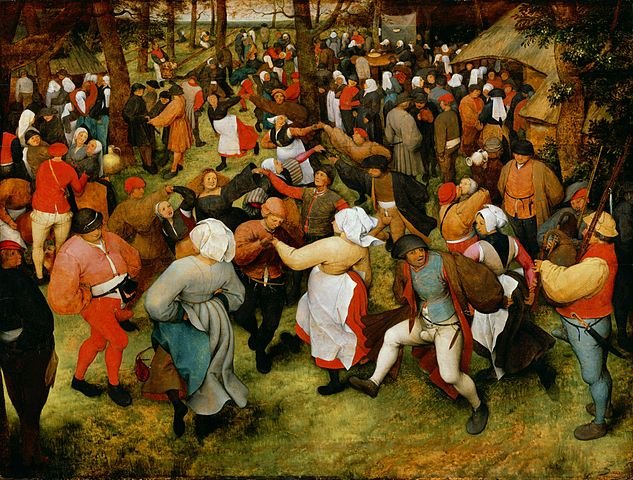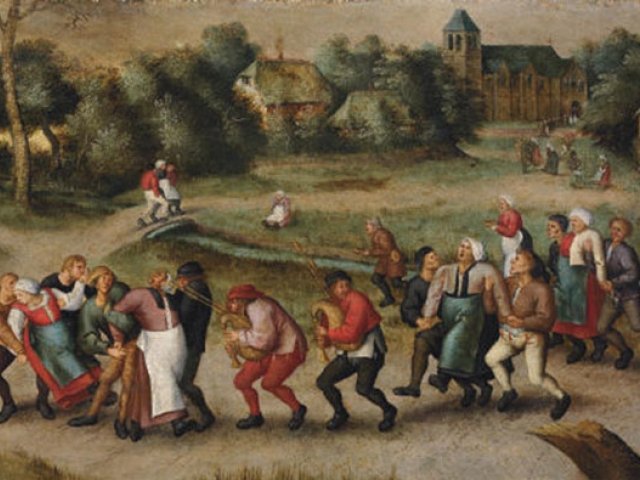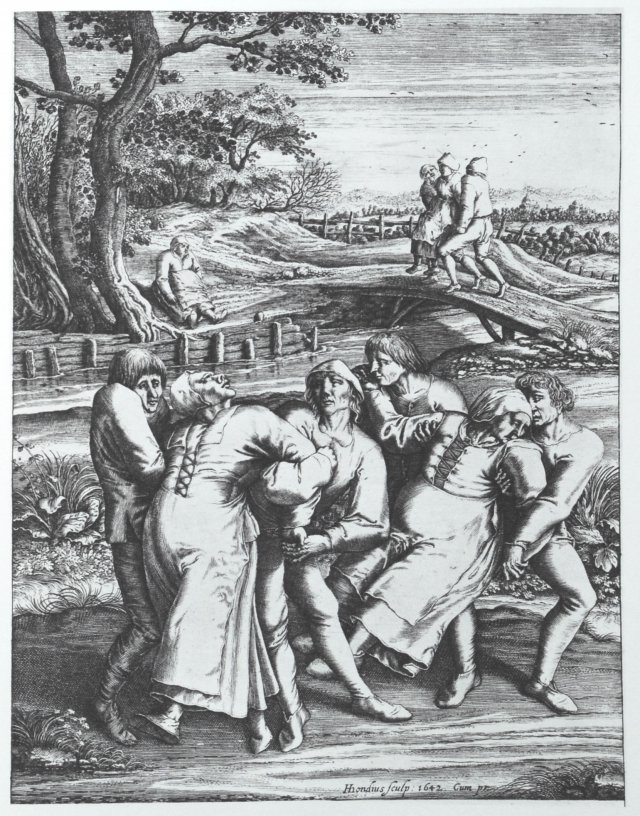Unexplained Phenomenon Of The Dancing Mania That Occurred During The Middle Ages
Ellen Lloyd – AncientPages.com - We live in a world full of mysteries. We often come across intriguing stories dealing with unexplained phenomena that make us even more curious about the realms we inhabit.
One such baffling event took place during the Medieval period in Europe.
In July of 1374 in Aachen, Germany, dozens of villages along the Rhine River were suddenly swept by a dancing plague called choreomania. For no apparent reason, hundreds of people took to the streets, leaping, jerking, and hopping to music.
The strange thing was that no-one else could hear the music except those who danced. How was it possible?
Another odd aspect of this story is that these people didn't want to stop dancing.
They did eat, drink or sleep. All they did was dance, shout, and hallucinate for days.
Sometimes, even when they fell, they continued to dance while on the ground. Obviously, they couldn't control their movements until finally, their weakened bodies collapsed from exhaustion.
This outbreak of dancing mania spread as far as France and lasted for several years. Almost just as suddenly as it had come, it disappeared.
This would be the end of this story, but something similar occurred in Strasbourg, France, back in 1518. A woman named Frau Troffea suddenly started to dance nonstop for days. Within a week, she was joined by 34 people and by the end of the month, the dancing plague had affected an estimated 400 people. Once again, people "danced themselves to death" for no obvious reason.
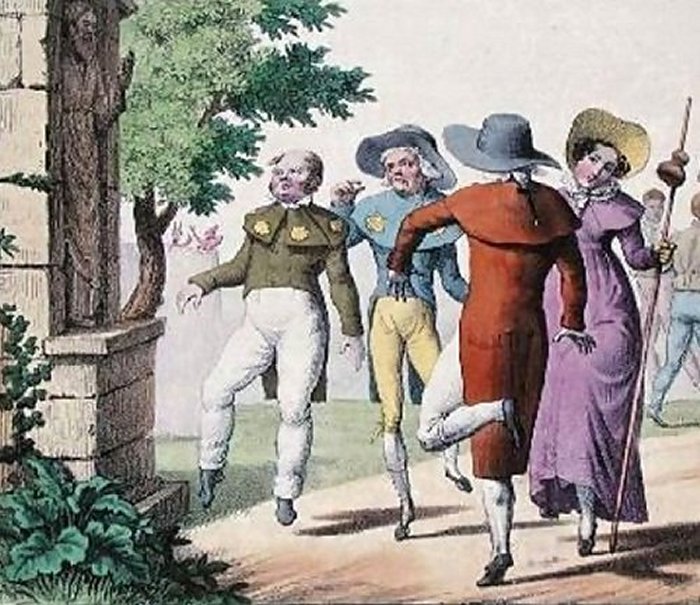
Dancing mania, also sometimes known as St. Vitus' dance, was first recorded in the 7th century and reappeared many times across Europe until about the 17th century.
It remains unknown what exactly caused the outbreaks of dancing mania. Some scientists have suggested the cause was mass hysteria. Other researchers explain this odd behavior as a mass psychogenic illness, which is a form of mass hysteria. This happens when a group of people mistakenly believe that they are afflicted with a common disease. Yet another possible explanation is ergot poisoning. Ergotism is contracted from a fungus that can grow on many grains, such as corn and rye. The symptoms of ergotism are very similar to those of dancing mania. It is possible that this fungus-infected food supplies of the afflicted areas.
Historian John Waller, author of the book "A Time to Dance, A Time to Die: The Extraordinary Story of the Dancing Plague of 1518," studied the illness at length and has solved the mystery. "That the event took place is undisputed," said Waller, a Michigan State University professor who has also authored a paper on the topic, which has been accepted for publication in the journal Endeavour.
Waller explained that historical records documenting the dancing deaths, such as physician notes, cathedral sermons, local and regional chronicles, and even notes issued by the Strasbourg city council during the height of the boogying rage, all "are unambiguous on the fact that (victims) danced."
"These people were not just trembling, shaking or convulsing; although they were entranced, their arms and legs were moving as if they were purposefully dancing," he said.
Waller suggested that stress-induced psychosis was behind the dancing mania that struck Medieval Europe. In those days, people suffered from famine, and many died of starvation. The area was riddled with diseases, including smallpox and syphilis. Waller believes the stress was intolerable, and hence a mass psychological illness resulted.
Waller also points out that superstition was widespread among the people. "Anxiety and false fears gripped the region," Waller said.
One of these fears, originating from a Christian church legend, was that if anyone provoked the wrath of Saint Vitus, a Sicilian martyred in 303 A.D., he would send down plagues of compulsive dancing.
The school was forced to shut down after more than half the students - 95 out of 159, were affected. Ten days after the school was closed, the plague struck a village 55 miles away and affected 217 for two months. The epidemic also spread through the countryside.
Such epidemics occurred in ancient times and can still happen today. As we have seen, there are several theories attempting to solve these mysterious outbreaks. Scientists may never be able to figure out precisely what caused the dancing mania outbreaks in medieval Europe.
The laughing epidemic in Tanzania requires further study and could solve the mystery of medieval dancing mania. Scientists believe that "in order to interpret this behavior as normal or pathological, a study of the cultural context should be made."
Again, perhaps we shouldn't compare ancient and modern outbreaks because they can have entirely different causes. In any case, despite the proposed theories, it appears that the Medieval Dancing Mania will remain an unexplained phenomenon that we will never be able to understand truly.
Written by - Ellen Lloyd – AncientPages.com
Copyright © AncientPages.com All rights reserved. This material may not be published, broadcast, rewritten or redistributed in whole or part without the express written permission of AncientPages.com
More From Ancient Pages
-
 Unusual Parcel With 500-Year-Old Horn Container Discovered In South Africa Sheds Light On Pre-Colonial Khoisan Medicines
Featured Stories | Feb 15, 2023
Unusual Parcel With 500-Year-Old Horn Container Discovered In South Africa Sheds Light On Pre-Colonial Khoisan Medicines
Featured Stories | Feb 15, 2023 -
 Why Coyote Wanted People To Die For Their Own Good – A Caddo Nation Legend
Featured Stories | Jun 18, 2021
Why Coyote Wanted People To Die For Their Own Good – A Caddo Nation Legend
Featured Stories | Jun 18, 2021 -
 Aegir – Jotun Lord Of The Stormy Seas Revered And Feared By Norsemen
Featured Stories | Sep 6, 2019
Aegir – Jotun Lord Of The Stormy Seas Revered And Feared By Norsemen
Featured Stories | Sep 6, 2019 -
 Is There An Ancient Anomaly In Our DNA? It Is Possible, Scientists Say
Featured Stories | Mar 6, 2025
Is There An Ancient Anomaly In Our DNA? It Is Possible, Scientists Say
Featured Stories | Mar 6, 2025 -
 Grutte Pier – Legendary Giant Frisian Freedom Fighter Who Sought Revenge
Featured Stories | Dec 20, 2018
Grutte Pier – Legendary Giant Frisian Freedom Fighter Who Sought Revenge
Featured Stories | Dec 20, 2018 -
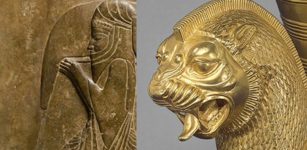 Peace Of Callias – A Treaty That Ended The Greco-Persian Wars
Ancient History Facts | May 15, 2019
Peace Of Callias – A Treaty That Ended The Greco-Persian Wars
Ancient History Facts | May 15, 2019 -
 Tikal Of Maya: Sophisticated Culture That Experienced Humble Start, Golden Age, Wars And Decline
Featured Stories | Apr 4, 2022
Tikal Of Maya: Sophisticated Culture That Experienced Humble Start, Golden Age, Wars And Decline
Featured Stories | Apr 4, 2022 -
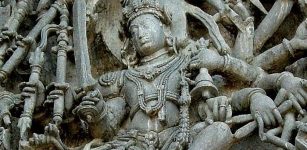 Chennakeshava Temple In Belur Is Richly Decorated With Scenes From Ramayana Mahabharata And Puranas
Featured Stories | Nov 18, 2021
Chennakeshava Temple In Belur Is Richly Decorated With Scenes From Ramayana Mahabharata And Puranas
Featured Stories | Nov 18, 2021 -
 Why Was Constantinople Called New Rome?
Ancient History Facts | Mar 9, 2020
Why Was Constantinople Called New Rome?
Ancient History Facts | Mar 9, 2020 -
 Mary Boleyn – King Henry VIII’s Other Woman And Sister Of Anne Boleyn
Featured Stories | Jul 24, 2018
Mary Boleyn – King Henry VIII’s Other Woman And Sister Of Anne Boleyn
Featured Stories | Jul 24, 2018 -
 Shango: Powerful Thunder God And Symbol Of Kingship Among Yoruba People Of West Africa
African Mythology | Mar 4, 2019
Shango: Powerful Thunder God And Symbol Of Kingship Among Yoruba People Of West Africa
African Mythology | Mar 4, 2019 -
 The Untold Story Of The Inca – Fire In The Sky – Part 1
Civilizations | Jul 2, 2019
The Untold Story Of The Inca – Fire In The Sky – Part 1
Civilizations | Jul 2, 2019 -
 Ars Amatoria – Ancient Roman Flirting Tips – Could They Still Work?
Featured Stories | Mar 26, 2019
Ars Amatoria – Ancient Roman Flirting Tips – Could They Still Work?
Featured Stories | Mar 26, 2019 -
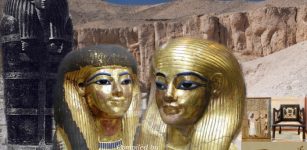 Amazing Tomb Of Yuya And Tjuyu Filled With Ancient Treasures In The Valley Of The Kings
Featured Stories | Jun 2, 2021
Amazing Tomb Of Yuya And Tjuyu Filled With Ancient Treasures In The Valley Of The Kings
Featured Stories | Jun 2, 2021 -
 Yakhchals: Ingenious Ancient ‘Refrigerators’ Could Store Ice In The Hot Desert
Ancient Technology | Sep 15, 2018
Yakhchals: Ingenious Ancient ‘Refrigerators’ Could Store Ice In The Hot Desert
Ancient Technology | Sep 15, 2018 -
 Archaeology Sheds Light On Why Some Ancient Societies Were More Unequal Than Others
Featured Stories | May 25, 2022
Archaeology Sheds Light On Why Some Ancient Societies Were More Unequal Than Others
Featured Stories | May 25, 2022 -
 The Mystery Of Blinking Mummy Of Rosalia Lombardo
Featured Stories | Jun 23, 2014
The Mystery Of Blinking Mummy Of Rosalia Lombardo
Featured Stories | Jun 23, 2014 -
 Eye Of Horus – Powerful, Ancient Egyptian Symbol With Deep Meaning
Ancient Symbols | Jan 21, 2019
Eye Of Horus – Powerful, Ancient Egyptian Symbol With Deep Meaning
Ancient Symbols | Jan 21, 2019 -
 8 Billion People: How Different The World Would Look If Neanderthals Had Prevailed
Featured Stories | Nov 18, 2022
8 Billion People: How Different The World Would Look If Neanderthals Had Prevailed
Featured Stories | Nov 18, 2022 -
 Hagar Qim: “Standing/Worshipping Stones” – Megalithic Complex In Malta Dated To 3600 – 3200 BC
Featured Stories | Feb 19, 2023
Hagar Qim: “Standing/Worshipping Stones” – Megalithic Complex In Malta Dated To 3600 – 3200 BC
Featured Stories | Feb 19, 2023

